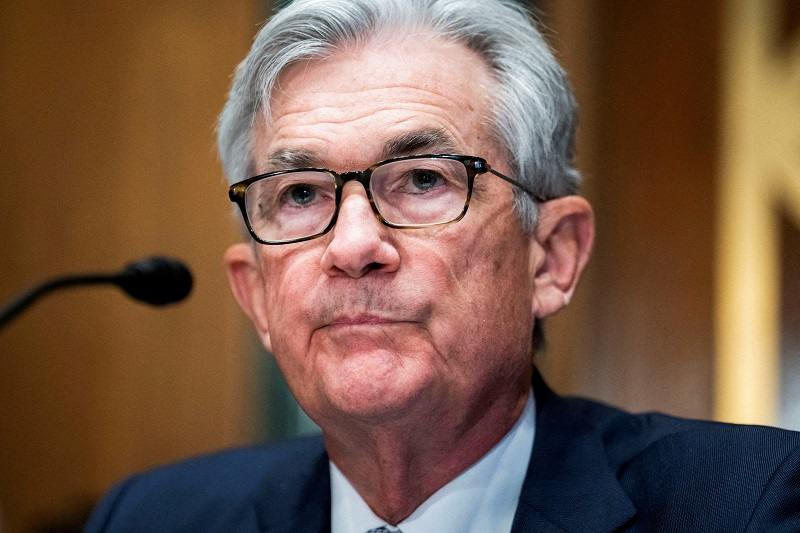
Federal Reserve Board Chairman Jerome Powell testifies before the Senate Banking Committee in Washington on March 3.
11:36 JST, April 22, 2022
WASHINGTON (Reuters) — A half-point interest rate increase “will be on the table” when the Federal Reserve meets on May 3-4 to approve the next in what are expected to be a series of rate increases this year, Fed Chair Jerome Powell said Thursday in comments that pointed to an aggressive set of Fed actions ahead.
With inflation running roughly three times the Fed’s 2% target, “it is appropriate to be moving a little more quickly,” Powell said in a discussion of the global economy at the meetings of the International Monetary Fund. “Fifty basis points will be on the table for the May meeting.”
In likely his last public remarks before the Fed’s next session, Powell also said he felt investors currently anticipating a series of half-point hikes were “reacting appropriately, generally,” to the Fed’s emerging fight against rising prices.
His comments appeared to pin down an expected rate path much steeper than projected at the Fed’s March meeting, when policymakers at the median anticipated the target overnight federal funds rate would be increased to 1.9% by year’s end.
Traders in contracts linked to the overnight federal funds rate currently expect the Fed to increase it to a range between 2.75% and 3% by then, a pace that would involve half-point hikes at three upcoming meetings and quarter-point increases at the year’s three other sessions.
That would take the Fed’s target rate beyond the “neutral” level and into territory that would begin to restrict economic activity, marking one of the faster turnarounds of U.S. monetary policy. In addition, the Fed is expected to begin reducing its asset holdings in a step that will further tighten credit conditions for businesses and households.
The potential speed of the Fed’s action has led some economists to warn a recession may now be more likely if business and households cut back spending more than anticipated as borrowing costs rise, or stock and other assets prices drop in value and eat into household wealth.
“I would put the probability that we enter into a recession over the next 12 months of about one in three, and that is rising,” Moody’s Analytics’ chief economist Mark Zandi said earlier Thursday at a session on inflation that Powell also addressed.
With aggressive rate hikes and balance sheet reductions ahead, “it’s raised the risks that the Fed navigating things gracefully, and landing … the economic plane on the tarmac, is going to be much more difficult.”
The interest rate on the 2-year Treasury note, the maturity most sensitive to expectations about Fed policy, rose above 2.7% for the first time since December 2018. Rising yields on both short- and long-term bonds are increasing costs for a variety of loans — most notably the 30-year mortgage commonly used to finance home purchases, where the average rate rose to over 5% this week — a key channel through which the Fed influences the economy.
Equities, meanwhile, added to their losses as Powell spoke. The benchmark S&P 500 Index .SPX was last down about 1.2%.
Powell acknowledged the Fed was walking a sensitive line between taming inflation and pushing the economy into a downturn.
“Our goal is to use our tools to get demand and supply back in synch…and do so without a slowdown that amounts to a recession,” Powell said. “It is going to be very challenging.”
“Powell is intimating that avoiding a recession will not be easy. That is new,” said Tim Ghriskey, senior portfolio strategist with Ingalls & Snyder in New York.
But undercutting the rapid pace of price increases, which have more than offset wage gains for most Americans and become a pressing political issue as well, is “absolutely essential” Powell said. “Economies do not work without price stability.”
Until recently, the central bank had expected inflation to ease with some outside help, as the reopening of the economy from the pandemic allowed the flow of goods around the world to move back to normal. Instead, new lockdowns in China and the war in Ukraine have threatened a new round of bottlenecks, higher energy costs, and uncertainty.
Powell said the Fed no longer expects any help, but will count on tighter monetary policy to curb demand for goods and services, and prompt businesses to reduce the demand for workers in an “unsustainably hot” job market.
“We have had an expectation that inflation would peak around this time and come down over the course of the rest of the year and then further,” Powell said. “These expectations have been disappointed in the past…We are not going to count on help from supply side healing. We are going to be raising rates.”
"News Services" POPULAR ARTICLE
-

American Playwright Jeremy O. Harris Arrested in Japan on Alleged Drug Smuggling
-

Japan’s Nikkei Stock Average as JGB Yields, Yen Rise on Rate-Hike Bets
-

Japan’s Nikkei Stock Average Licks Wounds after Selloff Sparked by BOJ Hike Bets (UPDATE 1)
-

Japanese Bond Yields Zoom, Stocks Slide as Rate Hike Looms
-

Japan’s Nikkei Stock Average Buoyed by Stable Yen; SoftBank’s Slide Caps Gains (UPDATE 1)
JN ACCESS RANKING
-

Keidanren Chairman Yoshinobu Tsutsui Visits Kashiwazaki-Kariwa Nuclear Power Plant; Inspects New Emergency Safety System
-

Imports of Rare Earths from China Facing Delays, May Be Caused by Deterioration of Japan-China Relations
-

University of Tokyo Professor Discusses Japanese Economic Security in Interview Ahead of Forum
-

Japan Pulls out of Vietnam Nuclear Project, Complicating Hanoi’s Power Plans
-

Govt Aims to Expand NISA Program Lineup, Abolish Age Restriction























